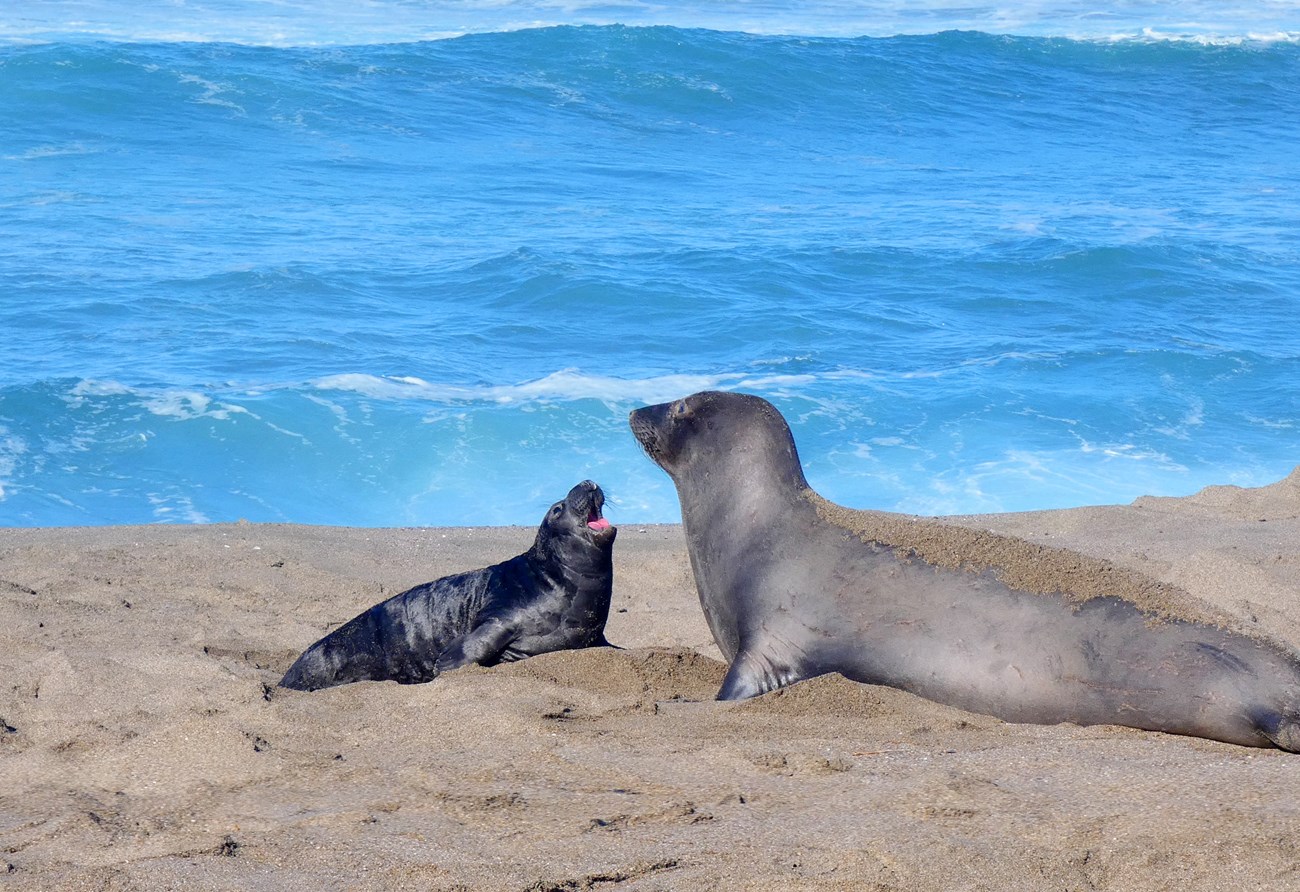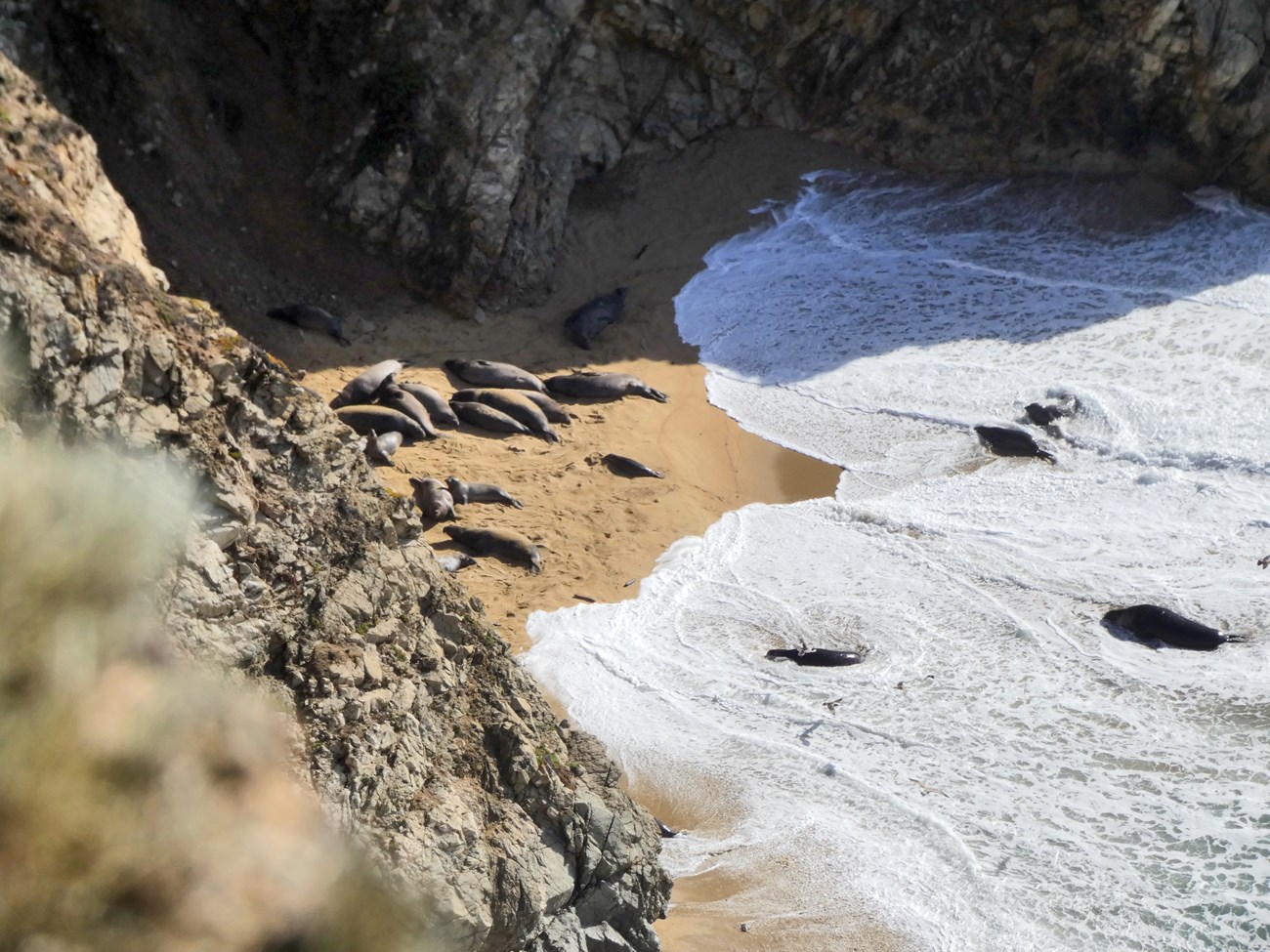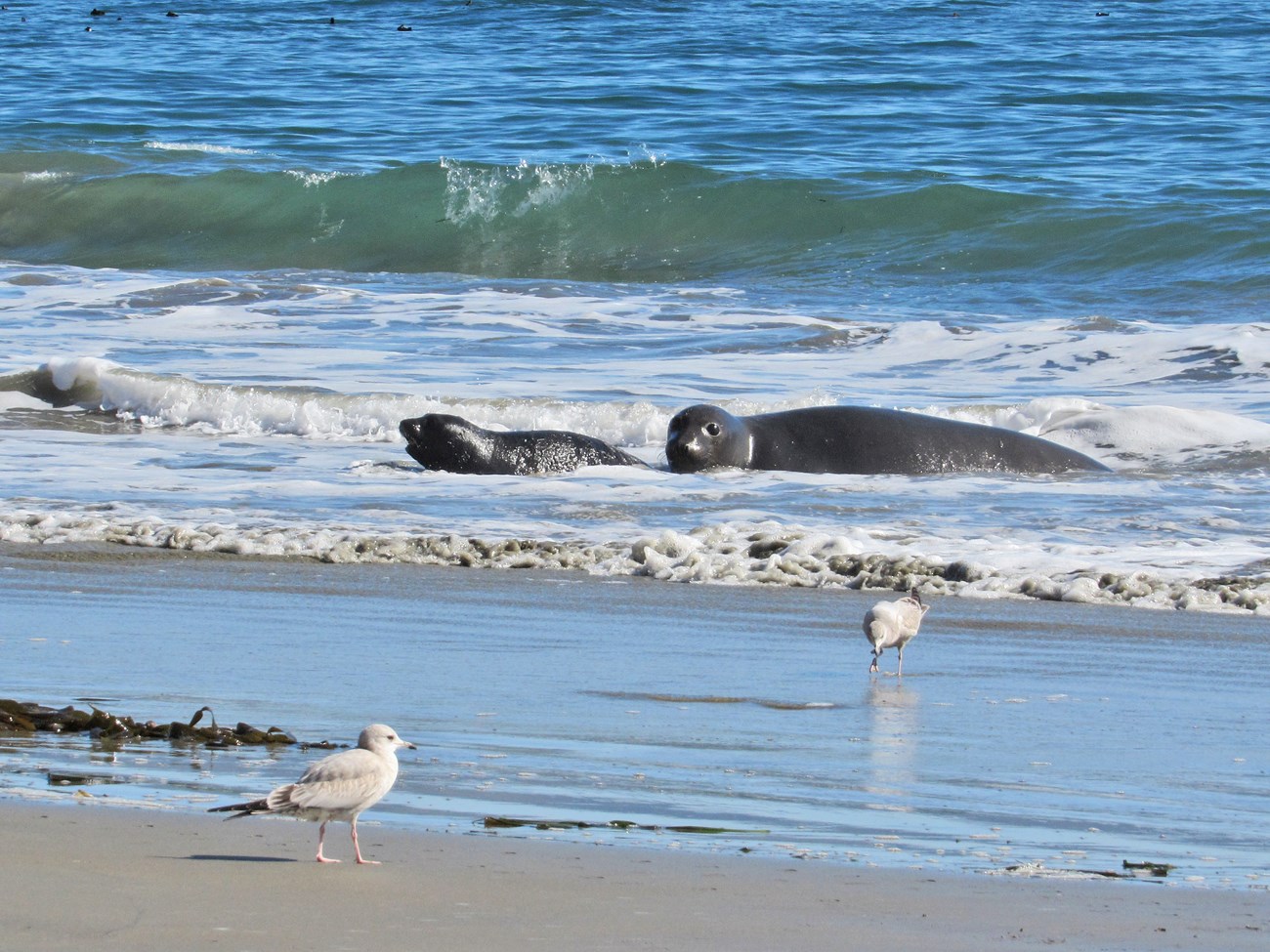Last updated: June 13, 2023
Article
The Rippling Effects of Climate Change on Elephant Seal Habitat
By Science Communication Intern Claire Baker, Point Reyes National Seashore Association

NPS / Marjorie Cox, NMFS Permit No. 21425
December 2022 - The female elephant seal is ready. It’s early January in Point Reyes National Seashore, and she’s been hauled out on Drakes Beach for a few days. She’s waiting—along with clamoring piles of other female seals—to give birth.
At the end of last year’s breeding season she mated with a male bull seal before setting out to sea. Now, nearly a year later, a wrinkly, healthy pup joins the Drakes colony. It’s now his mother’s job to look after him for the next few weeks, feeding him and keeping him safe from the world’s dangers. Since the pup can’t swim yet, the protection that the beach provides is crucial. His mother has to keep him away from the treacherous water until it’s safe for him to swim.
The seal mom’s choice to birth her pup on Drakes Beach this year might have been motivated partially by the treacherous conditions at another beach spot, the Point Reyes Headlands. Little does she know, climate change is the driving cause behind beaches becoming less hospitable for elephant seals.

NPS / Marjorie Cox, NMFS Permit No. 21425
The year before, the seal mom migrated to the beach at the Headlands, which, unlike Drakes, directly faces the open ocean and more turbulent waters. While weaning her previous pup, she was careful to keep him away from the dangerous ocean’s edge, but the crowded beach was small. When an extreme storm hit in the middle of winter, the combination of small beach, high tide, and tumultuous open water spelled disaster. Unable to help, the seal mom watched as her pup was swallowed by an oncoming wave and swept out to sea, still too young to swim.
These extreme weather events at Point Reyes have become more common as a result of climate change, and their frequency will continue to increase.
In recent years, more northern elephant seals (Mirounga angustirostris) are giving birth and weaning pups at Drakes Beach, where calmer waters make the chance of pup mortality from storms much lower. Extreme storms will still be increasingly common, but the impacts of them will be felt much less harshly on beaches sheltered in bays like Drakes compared to beaches facing the ocean.
National Park Service biologists have been monitoring the seals’ population numbers and locations since the colony first appeared in the 1980s. In 2015, the breeding colonies at the Headlands and Drakes were comparable, with nearly 300 adult seals each. Just three years later, park scientists recorded record numbers at Drakes, while the colony size crashed at the Headlands (see Figure 1). There could be many contributing factors to this shift, but they include the pressures of climate change making the Headlands beaches no longer an ideal habitat.

Drakes’ calm waters also allow the seal mom and her pup to adapt to another climate change impact: rising global temperatures.
Much like humans, elephant seals would like to cool off on a hot day. Unlike humans, they can’t turn the AC on. Historically, this hasn’t been an issue in chilly wintertime breeding seasons, but climate change is quickly raising the thermostat.
While still nursing their pups, perhaps on an unseasonably hot February day, elephant seal moms might respond to the heat by returning to the sea much earlier than expected. Usually, seal moms don’t go back to the water until their pup is fully weaned – and they definitely wouldn’t bring their non-swimming pups anywhere near the ocean’s edge. But on warm days, researchers have found moms bringing their pups to the water, positioning their pups so that the gentle and cooling waves of Drakes Bay can wash over them both. At a calm beach like Drakes, she knows this isn’t dangerous like it would be on ocean-facing beaches.

NPS / NMFS Permit No. 21425
The pressures of climate change, including warming air and increased extreme storms, have made the beaches at Drakes more appealing habitat than the beaches in the Headlands. But one day, climate change will transform Drakes Beach as well.
Drakes is a narrow, cliff-backed beach. As the sea level rises, this will become a problem: the available beach space will narrow with no way for the seals to move back.
Years later, future generations of seals might not find much of Drakes Beach left to lie on. Scientists project that seas in this area could rise as much as six feet by the year 2100, putting much of Drakes Beach underwater. The remaining area won’t be enough to support very many seals, so they’ll have to find new places to go.


Top image
King tide at North Drakes Beach.
Credit: NPS / Marjorie Cox
Bottom image
North Drakes Beach during a normal-to-low tide.
Credit: NPS / Sarah Allen
Biologists have been working on predicting where the seals might go next, and they think there’s a possibility that they will move on to nearby Limantour Beach. Limantour is also along Drakes Bay, with gentle waters and opportunities to cool off, but it’s backed by dunes instead of cliffs. Sea level rise will narrow Limantour too, but seals might be able to find more space to lie there.
It’s not clear what effects the seals’ movement onto new beaches will have on the local ecosystems, though. Limantour currently supports a complex ecosystem with many plants and animals that could be threatened by the lumbering approach of a massive elephant seal. The federally threatened western snowy plover, for instance, could be driven off the beach as seals unknowingly squash their delicate nests.
And that would be a climate effect, too. Seals will continue to be pushed to new locations in order to adapt to a changing world, and their movements set off ripple effects – literally, as huge male bulls shuffle down the beach, and figuratively, as ecosystems respond to the presence of new animals.
For now, elephant seal moms and pups are happy on Drakes Beach, and the population is booming. It remains to be seen exactly how climate change will play out on the beaches of Point Reyes. It’s likely, though, that seals will have to keep adapting as climate change continually strips them of habitat – and with changes for the seals come changes for all us organisms that live alongside them.
Want to help the elephant seals?
Here are a few ways:
-
Check out periodic updates from the elephant seal monitoring team.
-
Keep your distance! Use the elephant seal viewing areas to admire them from afar. This way, everyone is safer, and you get to see the seals acting more like they would in the wild. This article gives more information on seal viewing and protection areas.
-
Practice leave no trace when in nature, and do your part to leave the elephant seals undisturbed.
-
Volunteer as a docent in the Winter Wildlife program to spread awareness about the elephant seals!
Thank you to Marine Ecologist Sarah Codde for providing information for this article.
See more from the Bay Area Nature & Science Blog
